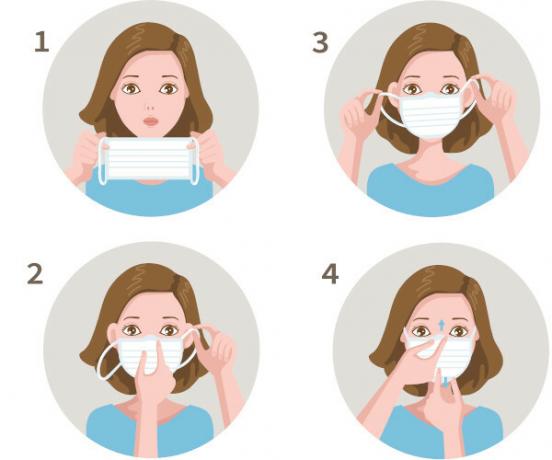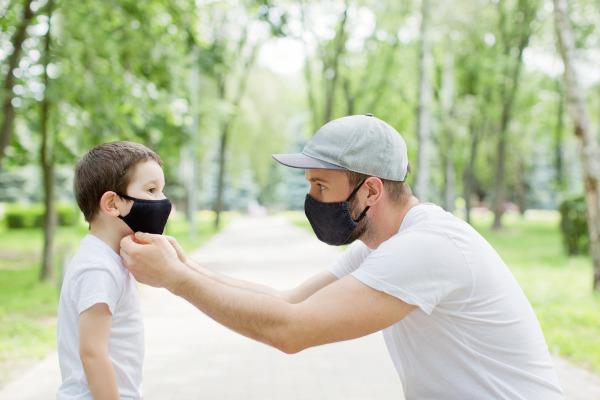At masks are a resource used by many people for airway protection. They can be of different types and can guarantee protection, for example, against dust, smoke and even microorganisms. In addition, they can prevent the spread of disease-causing agents by the patient himself. It is worth noting, however, that each mask has a distinct property and must be chosen according to the situation faced.
The use of a mask to protect the airways has gained prominence today due to the pandemic of colife-19. Many people began to question whether or not masks would be effective in protecting against the disease and who should use them. The World Health Organization (WHO) initially recommended that it be used only by health professionals, caregivers and patients, however, after analyzing several studies, it was concluded that masks are an important preventive measure and that its use by everyone in the population would help to contain the transmission of covid-19.
Read too: Coronavirus —the family of viruses responsible for the pandemic of çovid-19
Different types of masks and their efficiency
There are different types of masks to ensure protection of the airways. Some are able to guarantee protection against some chemical agents, while others are able to also protect against some disease-causing biological agents. Although many people think that the use of masks is restricted to health professionals, other groups can and should use this equipment. Professionals working in the industrial area, for example, must use specific masks for ensure protection against some gases and vapors that may arise during activities carried out in the industry.

With regard to the health area, masks are important to ensure, above all, the protection of workers that are subject to contact with etiological agents eliminated by the patient through speech, sneezing or coughing, and also to prevent the sick individual from dispersing these agents.
Those agents can be eliminated by droplets or aerosols (small particles that remain in suspension). The droplets are about 5 µm in size and can reach the nasal passages and the oral cavity. Aerosols, in turn, are smaller, remain in the air for a long time and can penetrate deeper into our respiratory system when inhaled. Some diseases are transmitted by droplets, such as whooping cough and the kashumba, and others are transmitted by aerosols, such as measles and of the tuberculosis.
Understanding how a disease is transmitted is essential to adopt effective protective measures, as the identification of the best type of mask to be used. For diseases transmitted by droplets, the surgical mask can be used on the patient and on the professional who will come into contact with the patient. The surgical mask also protects against the projection of blood and other body fluids that could reach the professional's airways. It is worth noting that surgical masks cannot adequately protect against aerosols, as they do not guarantee, for example, an adequate seal on the face.
To protect yourself from aerosols, the professional must wear respiratory protective equipment (EPR), which is a PPE (Personal Protective Equipment) that guarantees protection against the inhalation of agents that cause damage to health. One of these EPRs is the filtering semifacial piece, called a PFF, which is capable of retaining aerosols as well as droplets and, in some cases, body fluids.
There are different PFFs, which are classified into PFF1, PFF2 and PFF3 and vary in their filtration efficiency, with PFF3 being the one with the greatest protection. PFF2, which is equivalent to the mask known as N95 in the United States, guarantees protection against certain aerosols, being efficient, for example, in protecting against tuberculosis and also against non-biological particles, such as dust.
Read too:Difference between covid-19, flu and cold
Covid-19 and the use of masks
With the pandemic of covid-19, which began in 2020, medical authorities around the world began to question whether the use of protective masks could help to curb the disease. The importance of using specific masks to prevent transmission and contagion has long been recognized of diseases, being surgical masks, for example, already used by health professionals in different contexts.
Initially, WHO recommended the use of surgical masks only for people with respiratory symptoms, health professionals and people who were in contact with people with respiratory symptoms or suspected of having the disease. People without symptoms, therefore, would not need to use the mask.
Other health agencies, however, drew attention to the fact that asymptomatic people could transmit the disease without their knowledge and, therefore, the use of masks by the entire population could reduce this transmission.. After analyzing several studies, the WHO came to the conclusion that the use of a mask would be a fundamental measure to reduce the transmission of covid-19.

A fact that worried authorities at the beginning of the pandemic was the scarcity of masks on the market. According to WHO, the use of masks is essential for people who are on the front lines of combating virus, therefore, the use by the entire population could leave these professionals unprotected due to the lack of the product. In this context, to minimize this problem, the making of homemade masks emerged.
Is the use of cloth masks by the population efficient?
Fabric or homemade masks can be used by the population to reduce transmission and contamination by SARS-CoV-2. According to the Ministry of Health, these masks can act as a physical barrier against the virus. In order for them to work properly, however, WHO recommends that they have three layers:
- an innermost layer made of a hydrophilic material such as cotton or cotton blends;
- an outermost layer made of a hydrophobic material such as polypropylene, polyester or mixtures of these materials. The use of these materials is important to limit external contamination by penetration to the user's nose and mouth;
- a hydrophobic intermediate layer made of non-woven synthetic material such as polypropylene, or a cotton layer for better filtration or retention of droplets.
At fabric masks are for individual use, they should not be shared even by members of the same family. Its use should be done for about two hours, and it is necessary to change it after this period or when it is wet. After use, homemade masks must be sanitized.
THE WHO recommends that fabric masks be washed with soap or detergent and preferably with hot water, having at least 60°C. Also according to the Organization, if it is not possible to wash the mask with hot water, use soapy water at room temperature and then boil the masks for 1 minute. The recommendation of the National Health Surveillance Agency (Anvisa) is that the mask be washed in advance with water current and neutral soap and then soaked in water, soap and bleach or equivalent for about 20 to 30 minutes.
Read too: Social distancing - what it is and when it should be adopted
How to use disposable masks
Disposable masks are important for sick people and also for people who care for people who have diseases that can be transmitted through respiratory secretions, as is the case with covid-19. To use these masks, some precautions must be taken.

- Before using the mask, clean your hands properly, washing them well with soap and water or using 70% alcohol.
- Make sure the mask is in perfect condition for use, not containing torn regions, for example.
- Check the side that should face outward and identify the side that should face up.
- Place the mask on your face and squeeze the region of the metal band or stiffer edge so that it adapts to the shape of your nose.
- Adjust the mask so that it covers your mouth and nose, leaving as little space between your face and mask as possible. The bottom should cover the mouth and chin.
- During use, do not touch the front region of the mask.
- To remove, use the side straps and prevent the mask from coming into contact with your body or other objects.
- Immediately dispose of the mask in a closed trash can after use.
- After removing the mask, sanitize your hands.
- Never reuse disposable masks.
10 information about masks and covid-19 that everyone should know

1. The current recommendation is that the entire population use a protective mask in order to prevent transmission and protect themselves from covid-19.
2. Home masks can help prevent and control the disease, but they should follow some manufacturing recommendations. WHO suggests that masks contain three layers.
3. Masks should be changed after two hours of use or if they become damp.
4. The simultaneous use of two masks (surgical mask overlaid by a fabric mask) reduces the risk of transmission of the covid-19, according to a study released by the Centers for Disease Control and Prevention (CDC), a state health agency United.
5. Health professionals, during their activities, should not wear homemade masks.
6. Individuals who are at higher risk of developing severe cases of the disease, such as the elderly and people with comorbidities, should use surgical masks in situations where it is not possible to maintain distance physicist.
7. Caregivers and people who are living with the patient must wear surgical masks when they are in the same room as the patient.
8. The use of a mask does not exempt an individual from practicing other essential measures to prevent the disease, such as maintain physical distance, avoid crowding and always wash your hands with soap and water or sanitize them with alcohol 70%.
9. According to the Brazilian Society of Pediatrics, children under the age of two should not wear masks, as have a higher risk of suffocation due to intense salivation, small airways and immaturity motor.
10. Children older than two years old must wear protective masks to avoid contamination by the virus that causes covid-19. Younger children must always be supervised by an adult, it is essential that parents inform their children about the importance and correct form of use.
By Vanessa Sardinha dos Santos
Biology teacher
Source: Brazil School - https://brasilescola.uol.com.br/curiosidades/uso-de-mascara-de-protecao-e-sua-eficacia.htm
